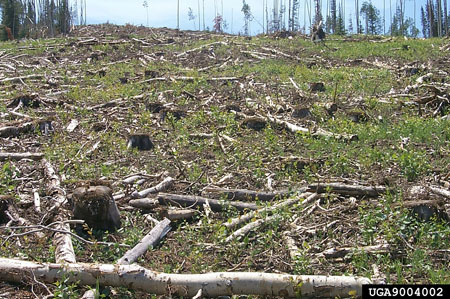Clearcutting is one of several harvesting systems utilized in the state to achieve certain goals create conditions to favor certain tree and wildlife species. When done correctly, they can maintain the long term sustainability of a fores.
If you hadn’t already guessed it, I am an advocate for active forest management. And by that I mean using ALL the tools available to a landowner to achieve their woodland goals. The most powerful of these tools is the timber harvest. For me, a timber harvest can be as small as the removal of a few scattered trees for firewood or as large as a clearcut.
For a long time now the clearcut, or the harvest of all of the merchantable trees in an area (and sometimes all of the trees), has had a bad reputation and it is shunned by many a landowner. Well I am here to tell you that clearcuts are not the environmental disaster many people believe them to be. In fact, clearcuts offer a wide array of ecological benefits – it all depends on your objectives for your land.
Let’s discuss the environmental disaster part first: Wide spread erosion, loss of mature forest cover and related habitat, and not very aesthetically pleasing. These are just a few of the arguments made to portray clearcuts as harmful to the environment and why landowners prefer not to conduct a clearcut.
Soil erosion can be a problem on any timber harvest. Numerous studies have shown that it isn’t the harvest of trees per se but improper road and trail construction and use that cause the overwhelming majority of soil erosion problems. This is especially true when proper road building standards or Best Management Practices are not adhered to. Clearcuts are unique in that the removal of all merchantable trees may allow rainfall to strike the ground with its full force. This is not a problem in most cases because there is usually sufficient groundcover and slash to intercept the rain and moderate slope to limit runoff.
Clearcuts should not be prescribed on steep slopes where the soil is highly erosive and where the ground vegetation will be removed. It is the job of the landowner, the forester, and the logger to ensure that the right road building techniques are chosen and implemented and that clearcutting is appropriate for the site to reduce the chance for erosion.
There is no question that conducting a clearcut in your forest will dramatically change its character. For many people it is no longer a forest, but a field. In fact, it is not a field that is created but the start of a new forest. A clearcut simulates a natural disturbance such as a windstorm or an ice storm that replaces an old forest with a young forest. The young forest starts to grow almost immediately following the removal of the mature trees. This natural process of replacing one forest type with another (called succession) will take place unless you pave over the clearcut area, mow it or plow it every year, or improperly graze livestock in it.
I have talked with many landowners about their concerns regarding an upcoming clearcut taking place on their property. Much of their concern revolves around the loss of trees they love or views they enjoy. What they discover following the harvest is that they “can finally see” across their land, that they have different wildflowers growing in the opening, and that they have new wildlife visiting their property. Ultimately, some come to enjoy the openings created by clearcutting, and think it is all growing back into a thick stand of trees too quickly.
For many landowners, clearcuts are appealing because they attract important game animals like deer, ruffed grouse, woodcock, and black bears. Indeed many wildlife are adapted to the habitat created by clearcuts or openings created by windstorms or ice storms. With the declining use of clearcuts on private lands, large openings are becoming less common, reducing the populations of some wildlife species, such as the golden-winged warbler, that are dependent on brushy habitats.
Clearcuts add important diversity to the large forested landscape. Selective harvests (or cutting a few trees here and there) favor one species over others. In the same way, clearcutting favors species that grow best in full sunlight and not as well in the shade of other trees. Examples of sun loving trees include aspen and jack pine. A patchwork of different management prescriptions leads to more wildlife diversity and a landscape that can better withstand an assault by insects or disease.
Clearcuts are just one of the many tools you can utilize to achieve your goals and maintain the long-term sustainability of your forest. But like all tools, their utility arises from their skillful application in the right situation. I encourage everyone who is planning a timber harvest to consider conducting a clearcut if it fits their objectives for their property.
